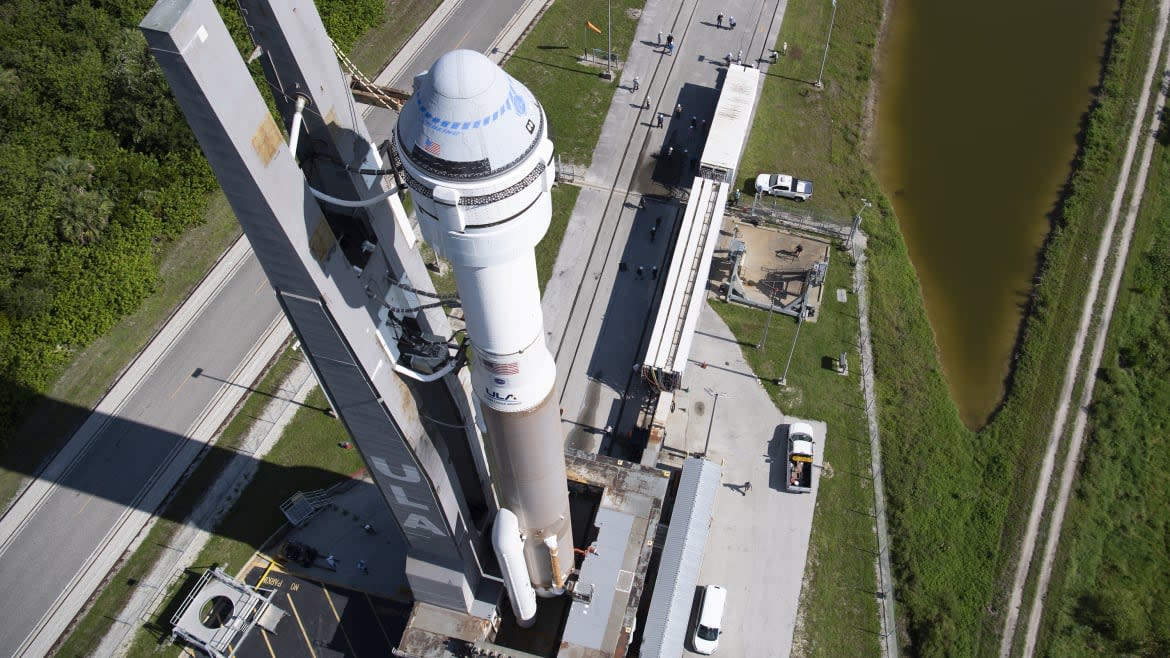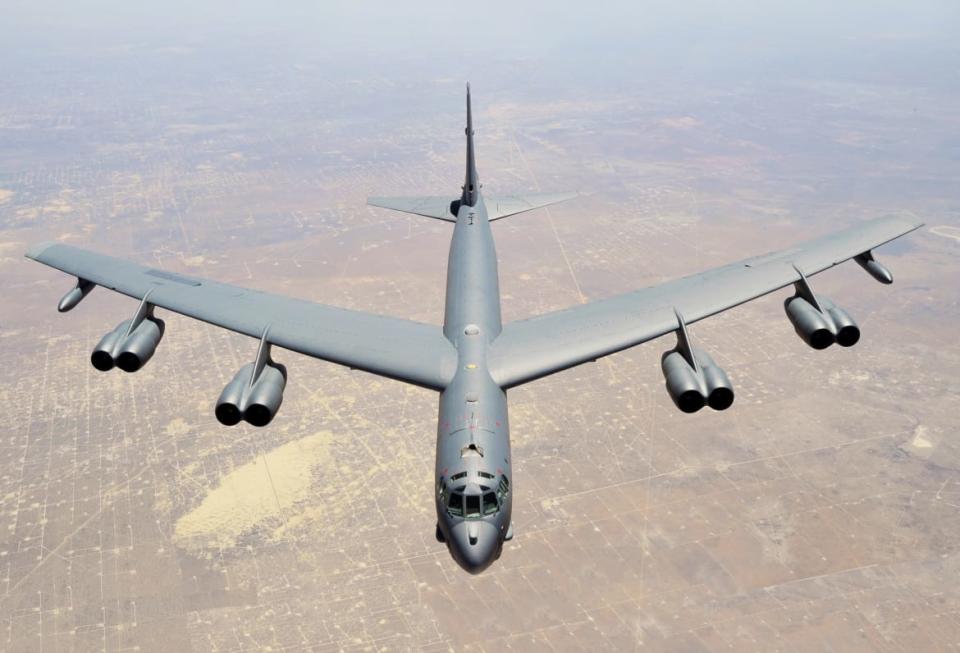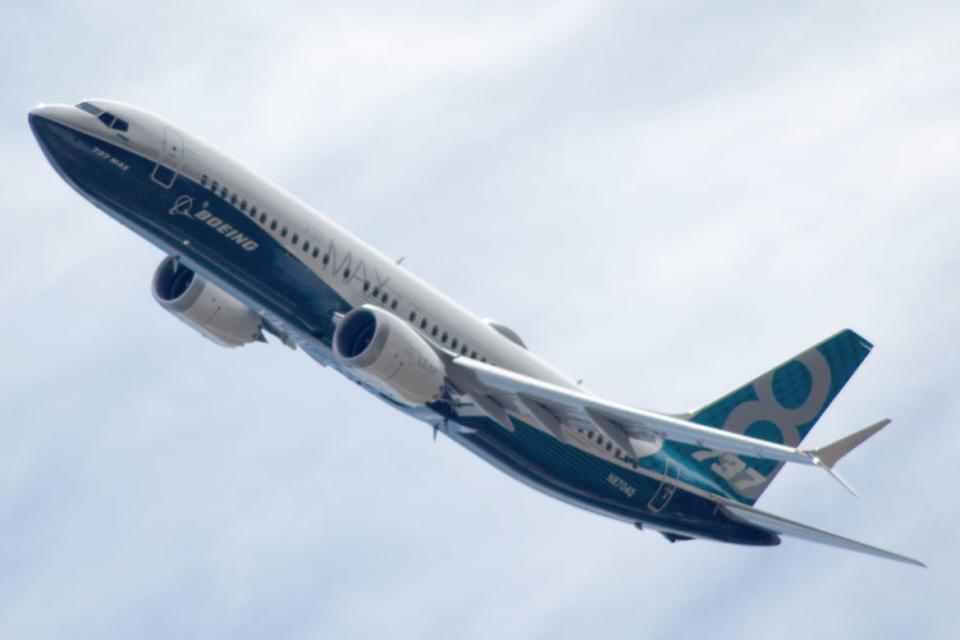The Stakes for Boeing’s Second Starliner Space Mission Are Astronomical

Can Boeing begin to repair its battered reputation with one rocket launch? Its Starliner capsule now sits atop an Atlas 5 rocket on a pad in Florida, being readied for a flight to the International Space Station Thursday evening, as part of a test program already two and a half years behind schedule. NASA wants to use Starliner as a new vehicle to send its astronauts into space, as an alternative option to SpaceX’s Crew Dragon. But Starliner has yet to be cleared as safe enough to make a crewed flight because of potentially life-threatening glitches in its systems. SpaceX is sending astronauts, wealthy tourists, and even a few lucky citizens to space with regular insouciance—while Boeing’s human spaceflight ambitions are facing a make-or-break moment come 6:54 p.m. Eastern Time Thursday.
Serious technical failures run wide and deep throughout Boeing’s sprawling business, from aerospace to military programs. A successful Starliner test flight would certainly help, but it would do little to counter the picture of a once peerless innovator falling badly behind its competitors.
Indeed, the problems of the Starliner inevitably prompt analysts to suggest a classic case of industrial Darwinism—that, by its nature, Boeing can never match the game-changing brilliance of Elon Musk’s SpaceX programs because its engineering culture has been gutted by cost-slashing and its executives have become risk-averse.
The striking difference in the performance of the two space programs so far would seem to validate that conclusion. But the company rot began long ago, in other places. To understand just how far Boeing has fallen and why, it’s instructive to go back to a time when its reputation was being built, to flashes of intuitive genius in a company that did, literally, change the world.
Boeing’s Capsule Successfully Lands After Mission Test Fail
What Goes Up, Must Come Down
In October 1948, four of Boeing’s top engineers were called to a suite at the Van Cleve Hotel in Dayton, Ohio, for an emergency meeting along with two top company executives, Ed Wells and George Schairer. Wells had fathered the legendary World War II B-17 bomber. And, at the close of the war, Schairer had found and copied Nazi research papers on high-speed jet flight, and used them to design the B-47 bomber, the world’s first large jet and a Cold War weapon that gave the U.S. air superiority over Soviet Russia.
The Boeing men were in Dayton to meet the U.S. Air Force’s top brass, who had decided they wanted a jet bomber twice the size of the B-47, and they wanted it fast. In one weekend, Wells and Schairer intuitively set out the shape of a new jet while the others projected its performance. Schairer—using balsa wood, glue and model paint from a hobby store—made a 1/120th scale model of it.
Boeing was awarded the contract, one of the most lucrative military programs it ever landed. But it was actually four more years before the bomber flew. Boeing had to wait for Pratt & Whitney to develop new jet engines powerful enough to meet its demands. Incredibly, 70 years later, that bomber, the B-52 (otherwise known as the BUFF—big, ugly fat fucker) is still flying with the Air Force. It is currently being upgraded with new engines and systems to enable it to launch cruise missiles, and could still be flying in the 2050s.
Stories like that tend to turn into company legends, and legends can get inflated. When I first heard it, more than 30 years ago, I suspected that it might have been sexed up a bit over time, but I was able to check it out with Schairer, and he confirmed it in detail.
Schairer was a legend himself, often irascible with lesser wits, able to look at the outlines of a new jet and immediately detect potential flaws. (On one occasion, he and Wells killed a new airplane program in a single meeting.) The striking point to me was how personalized Boeing’s intellectual capital was. Just about every step forward they made could be attributed to the brilliance of either individuals or small teams: from the way a cabin door ingeniously sealed on closing to how a serious flight control issue was resolved, more or less overnight, by improvising with existing parts.

A B-52 Stratofortress.
There are familiar explanations of why Boeing lost that culture. One is that it was extinguished by bean-counters drafted into the executive suites from McDonnell Douglas when the companies merged. Another is that aerospace technology has become so much more complex that the opportunity for acts of individual genius no longer exists.
There is no doubt that there were some truculent egos at large when Boeing became a byword for excellence, nor is there any doubt that some of the most brilliant engineers didn’t give a shit about the bottom line. But the inescapable historical fact is that it was Boeing’s ability to successfully manage such a collection of brain power that marked it out and made it singular. And my hunch is that today, Elon Musk would have had no trouble managing and enabling such a culture had he been lucky enough to acquire it.
That said, the most catastrophic hit to Boeing’s reputation, the grounding of the 737-MAX after two fatal crashes, can be traced back to that team of engineers, though that outcome was not of their making. In fact, at Boeing we’re looking at a kind of corporate cannibalism, in which a creatively bankrupt culture raids the foundational culture for treasure and destroys its quality in the process.
The 737 became the greatest cash cow in Boeing’s history, with more than 10,000 delivered, but it had a troubled birth. It was the brainchild of Jack Steiner, a gifted engineer with a personal velocity that, it was said, could “walk through walls.” When Steiner advocated a new small jet in 1965, Boeing’s boss, William Allen, was not persuaded and intended to veto it at a board meeting. Steiner risked being sacked by going behind his back and lobbying directors. Allen, outvoted, was furious, and never trusted Steiner again.

A Boeing 737-MAX in the air in the U.K.
His doubts seemed to be borne out by the results: Early versions of the 737 were plagued with problems and airlines complained that Boeing had delivered a dud. A turning point came in 1981, when new engines and other changes produced a jet that the airlines suddenly loved—Southwest Airlines built the original budget airline model around it.
All the flaws in the 737-MAX stem from the attempt to take that airplane, whose limits are set by its origins in the 1960s, and push it into one more upgrade. And now, even though the 737-MAX has been allowed back in the air, those limits are still raising serious issues of safety.
Both fatal crashes, involving jets operated by Indonesia’s Lion Air and Ethiopian Airlines, revealed that pilots were confused by a cascade of audio and visual warnings in the cockpit of systems failures. The pilots did not cause the crashes, they were desperately trying to respond to the cause—errant software that allowed the airplane to override the pilots and trigger a near-vertical death dive. But the 737’s cockpit alert system falls well short of state-of-the art systems on all other jets—including Boeing’s.
When the 737-MAX was cleared to fly again, the FAA agreed with Boeing that the existing cockpit alert system was sufficiently safe. Airline pilots were familiar with it and it was common across several generations of the jet. But, after investigating the crashes, lawmakers passed a bill in 2020 that mandated that any new jet certified as safe by the FAA after December 27, 2022, would require a new digital cockpit alert system.
There were two new 737-MAX models to be certified before that deadline: the smallest of the series, the 737-7; and the largest, the 737-10. Both were important additions—Southwest needed hundreds of the small jet to meet demand on shorter routes, and the larger jet was Boeing’s only chance of competing with the Airbus A321XLR, a jet that airlines are snapping up for transoceanic routes.
Now it seems that meeting that deadline for the two jets is problematic. The FAA is being far more rigorous in the certification regime, and the performance of the cockpit alert system is under review. On an earnings call with analysts in April, reporting a first quarter loss of $1.24 billion, Boeing CEO David Calhoun, in a masterclass of understatement, said that if they did not meet the deadline (or if it is not extended) “it is a problem.”
The problem is that, apparently, there is no way that the 737 cockpits can be retrofitted with a completely new digital alert system. This was explained to me by an expert with long experience of Boeing jets and the evolution of their cockpit technology: “To achieve that kind of generational change requires the aircraft to have a digital backbone, and digital capable systems and sensors. That is not possible in the current 737 design.”
All subsequent Boeing jets were designed to have that “digital backbone” that could accept continual upgrading, but the 737, with its 1960s architecture, was like a house that needed rewiring and the cost of gutting the house was too much— as the expert told me: “It would have required major systems changes, a complete revamp of the overhead instrument panels in the cockpit, massively different interfaces for engines and systems.”
Boeing is looking at a fix to the alert system that could be done within the existing architecture, but the expert was dubious. “It would be like someone with a ’53 Chevy taping an iPhone to the dash and expecting Siri to activate anti-skid braking, all-wheel drive and confirm that all aspect airbags were disarmed.” He felt that Boeing should have made more radical upgrades of the 737 in the 1990s or, at the latest, when it committed to the MAX in 2011.
Systemic Failure
As it is, the MAX saga is just one part of a broad collapse in Boeing’s engineering standards. The commercial division recently reported a first quarter loss of $856 million which reflected the discovery of serious flaws in its next big jet, the 777X, including a flight control issue that, as in the case of the 737-MAX, led in a test flight to an “uncommanded” sudden pitching down of the nose. Another costly and persistent problem is quality control failures that for a while brought the production line of the 787 Dreamliner to a standstill.
Discussing this dire picture, Calhoun told financial analysts in the April earnings call, “We keep trying to incorporate all our learnings, and it is definitely a more rigorous process that we’re all going through.”
What Calhoun didn’t talk about was something that he believes offers Boeing the chance to escape in one leap from the morass of engineering cockups to a new way of building airplanes. When Boeing won the contract to provide the U.S. Air Force with a new trainer, T-7A, a lot of the credit went to an innovative design regime named model-based system engineering, or MBSE.
Designing a new jet, particularly a large airliner, is one of the most complex engineering challenges in the world. Many thousands of parts, produced by thousands of suppliers across the globe, have to be impeccably manufactured and then finally assembled in one place. Critical systems have to be tested to extreme standards. As the 737-MAX showed, there is always a tension between meeting deadlines and not cutting corners that jeopardize safety.
How an Unearthed Black Box Could Crack the Boeing 737 Plane Crash Mystery
MBSE has been around as a concept since 1993, and is in its sixth generation. As well as using it on the all-new trainer, Boeing applied it to the 777X, which is an extensive makeover of the 777 that first flew in 1994. Techie evangelists praise the model-based system in Orwellian terms, as “the single source of truth.” At Boeing, that essentially means scrapping the old company hierarchy of specialist groups (“smashing the silos” is the jargon term) and concentrating the whole program under the new system—in effect, giving it total control of the design, development and manufacturing of an entire airplane, from the first concept sketch to the first flight.
The Air Force said that the costs of developing the T-7A were “significantly reduced” as a result of using MBSE. That’s something that Calhoun, who has made a personal mission of slashing costs (and firing people) finds irresistible. Developing a new commercial jet can cost upward of $20 billion. Boeing’s top managers see this choice as a game-changer. They believe they can leap at least a decade ahead of their rival, Airbus, by going all-in with MBSE, when they finally green light their first new jet for two decades, the 797, a replacement for the 737.
However, that “single source of truth” is not yet infallible. MBSE failed to anticipate and prevent the flight control issues on the 777X, and there was a similar failure with the T-7A when Air Force test pilots suddenly found that if they pulled the jet up into a steep climb it developed a disturbing tic known as “wing rock” that could lead to falling out of the sky. That has now been fixed by a change in software, but the FAA is far from finished with multiple systems issues on the 777X. Certification is taking so long that, by delaying delivery of the first airplanes, it is costing Boeing at least $1.5 billion.
Since 2005, under three successive CEOs, Boeing has regarded engineers as an expense, not an asset. To Calhoun, MBSE promises a way of producing a new airplane with as few engineers as possible. But this might easily turn out to be an example of people in a deep hole grabbing too eagerly for a panacea.
And there is also a larger question: Can artificial intelligence ever be a substitute for the kind of human intellectual capital that gave Boeing its command of the skies—the kind embodied in that sometimes ornery, often risk-taking cohort of engineers? In trying to make people think like machines, instead of independent minds, you can end up with just lines of software that, as in the case of the 737-MAX, lead to disaster.

Conceptual art of the Boeing Starliner in orbit.
Make-or-Break
As it is, in the hard reality of now, the approaching white knuckle moment for Boeing is the launch of the Starliner. The program has already cost Boeing $595 million more than the $4.3 million NASA provided in a fixed-price contract. By contrast, SpaceX won its contract with a bid of $2.5 billion. It has a fleet of four Crew Dragon capsules, and is readying its seventh mission to the ISS for later this year.
The last planned launch of the Starliner was aborted nine months ago when a problem showed up in the propulsion system used to steer the capsule in space. This was not another recondite software issue. It was basic plumbing that you might think you could call HomeAdvisor to service: Thirteen fuel valves were stuck due to corrosion in the pipes. Reuters reported last week that Aerojet, the makers of the system, alleged that chemical cleaners used by Boeing on the launch pad were responsible. Boeing rejected that assertion. The propulsion system has been replaced by another, and NASA has cleared it to fly.
However, the shadow of Boeing’s management style still hangs over the launch. Last week, the independent panel of experts that advises NASA on safety issues warned that Boeing’s staffing levels on the project “seem to be especially low” and that safety certification of the parachutes, deployed on the final phase of the capsule’s return to earth, was “lagging behind.” More ominously, Patricia Sanders, chair of the panel, was doubtful that Starliner will be ready to fly astronauts soon: “it is still a ways off before we have two fully functioning, operational vehicles.”
Get the Daily Beast's biggest scoops and scandals delivered right to your inbox. Sign up now.
Stay informed and gain unlimited access to the Daily Beast's unmatched reporting. Subscribe now.

